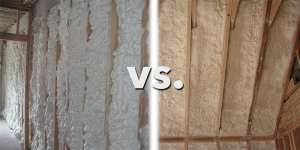1st Annual Company Picnic!
Work hard play hard. We are excited to announce the first annual Key Insulation and Builders Energy Rater Family Company Picnic being held on June 3, 2017. Along with hamburgers and hot dogs there will be adult and kid games. Most importantly there will be a managers dunking booth!
San Antonio home sales growth persists, but shows signs of weakening
by San Antonio Business Journal
San Antonio’s residential market over the past couple of years has been like a toddler at a birthday party — hyper and with no time to take a break, but finally showing signs of needing a nap.
The San Antonio Board of Realtors posted increases for the number of homes sold as well as rising average and median home sales prices. However, the jumps are lower than the increases posted over the past two years. The market may be beginning to retreat from its growth spurt.
The number of homes sold last month rose by 3 percent to approximately 1,954 sales. That number increased by 14 percent and 10 percent in 2015 and 2016, respectively.
While the rate of growth has backed off, there is one figure that hit a milestone last month. The market’s median price for a home rose past $200,000 for the first time. Thanks to a 6 percent increase, the median price is now $201,500, up from $190,800 in February 2016.
SABOR stated in its monthly report that the majority of homes in the San Antonio area continue to be priced below that $200,000 level, but local analysts have agreed that won’t be the case for long.
Earlier this year, Metrostudy Regional Director Jack Inselmann said homes costing less than $200,000 were becoming “an endangered species,” largely due to a lack of new affordable housing construction.
For now, however, homes priced below that six-figure mark still make up 49.5 percent of the city’s sales. Homes priced between $200,000 and $500,000 make up 46.1 percent. Only nine homes of the more than 1,950 listed were priced at or more than $1 million.
“Though prices here have grown, the increases are steady and sustainable unlike many other large cities in the country,” Michele Bunting Ross, SABOR’s chairwoman of the board, said.
February’s housing inventory of 3.3 months was also the 18th consecutive month of inventory remaining below four months, a sign that even if the market begins to slow down, prices will be bolstered by a lack of supply.
Katie Burke covers residential and commercial real estate, retail and law firms for the paper
Vast Majority of U.S. Homes Are Under Insulated
By RESNET
It’s hard to believe but 90% of existing American homes are under insulated. That means 90% of existing American homes are wasting money, energy and are not providing their owners with optimal comfort. In addition to this, they are also having a negative impact on the environment.
The numbers are derived from the 2009 Residential Energy Consumption Survey, which used methods developed by the Lawrence Berkeley National Laboratory to estimate insulation levels. Researchers at Boston University had already applied these methods as part of a study into potential energy savings and emissions reductions through increased insulation levels in family homes.
According to Dr. Jonathan Levy, Professor of Environmental Health at Boston University School of Public Health and the lead researcher on the Boston University team that conducted the study, “If all U.S. homes were fitted with insulation based on the 2012 International Energy Conservation Code (IECC), residential electricity use nationwide would drop by about 5 percent and natural gas use by more than 10 percent.” The study showed that by increasing insulation in U.S. homes across the country, not only did energy usage decrease but there was also a reduction in carbon dioxide emissions as well as other pollutants.
When addressing home comfort issues, most homeowners think of windows and doors first, and about sealing air leaks around those areas because they are the most visible indicators of home energy efficiency problems. What they don’t realize is that insulation has a much greater impact (up to three times as much) on the average home’s energy and comfort than windows or doors. Assessing a home’s insulation takes only a few minutes, and the resulting improvements can produce a significant increase to home comfort, as well as substantial reductions to home energy bills.
To learn more about how you can improve your home insulation, contact a certified RESNET Home Energy Professional.
What’s In Your Walls?
Spray Foam: Closed-Cell vs. Open-Cell
Open-Cell and Closed-Cell Foams: What’s the Difference? The importance of distinguishing between the two types of spray polyurethane foam cannot be understated. When it comes time to insulate a home or commercial building, you must opt for open-cell foam or closed-cell foam, or a specific combination thereof. Each type of foam distinctly impacts project costs, application methods, and building performance. There are two major factors distinguishing closed-cell and open-cell foams: structure and density.
Cell Structure: The structure of open-cell foam consists of tiny bubbles or cells that aren’t fully encapsulated–they are broken, torn, ripped, etc. Because they’re broken, air fills the open space inside the bubble, which results in a soft, spongy material. Closed-cell foam differs in that every bubble or cell that makes up the foam is completely encapsulated and packed tightly together. The bubbles aren’t filled with air, but rather a gas that aids foam expansion and insulation properties. This results in an altogether harder, stronger material than open-cell foam. The blowing agent, which aids in forming the bubbles or cells that make up SPF’s foam structure, is usually water for open-cell and high-R-value chemicals for closed-cell.
Material Density: Closed-cell foam is roughly four times as dense as open-cell for insulation applications. To ascertain foam density, one cubic foot (cu. ft.) of foam material is weighed. Open-cell tends to be roughly 0.5 lb./cu. ft. in density, whereas closed-cell ranges from 1.7 to 3.0 lb./cu. ft. in density, or even higher for certain applications. (Note: these density figures are rough averages. Every SPF product will vary based on its formulation.)
Properties: Of the two types of SPF, closed-cell foam is stronger, is a better insulator, and is more resistant to the transmission of air and water vapor. Because closed-cell foam is denser, however, it requires more chemical material per unit volume than open-cell, and is therefore more expensive to install–even if comparing the cost-per-R-value.
Insulation Value: R-value is a way to denote a material’s insulating properties, and the higher the number per unit thickness, the better the insulation value. Closed-cell spray foam has an R-value of about 6.0 per inch (R-6), while open-cell SPF comes in at roughly R-3.5. (Note: these R-values are rough averages. Every SPF product will vary based on its formulation.)
Usage: The deciding factor in opting for either open-cell or closed-cell foam is frequently based on application-specific performance characteristics like the structural integrity, control of water vapor, and the amount of available space to install the foam. For example, closed-cell foam is really the only option for residential roofing adhesive, due to its strength characteristics. In addition to the situation-specific considerations, there are more general considerations to make when deciding between open-cell and closed-cell foam. For instance, open-cell is typically inappropriate for below-grade applications or any applications where it could come in direct contact with water, while closed-cell foam isn’t advisable for sound-deadening applications, as open-cell foam is superior and less expensive.
Of course, it’s a good idea to discuss the type of foam for your project with your SPF installation professional prior to the job beginning. Also, it’s always prudent to contact a supplier for complete performance specifications and application information for their line of materials.
Words of Wisdom
Whose is what?
As we entered April and looked to that infamous day…the 15th, tax deadline day. Maybe you had braved the numbers; maybe you put it off, delaying the bitter pill. Regardless, the day pressed in. For you procrastinators, there was good news…the actual date this year was April 18th because of a weekend and Monday holiday. I had not done mine yet: my wife, half joking (I think) asked if she should plan to be out any certain day that I decide to tackle the inevitable. Last year was a painful experience, and let’s just leave it at that.
Yet pay our taxes we must. Regardless of opinion or feelings, we must pay or face dire consequences. The people in Jesus’ day enjoyed taxes as much as we do, or rather dreaded them as much as we do. Their system was such that even more inequities and underhanded business took place. Therefore, when some religious leaders caught up with Jesus, they asked him a question they thought would finally trap him and turn either the people of Israel or the people of Rome against him. In Mark 12:13-17, we find to back and forth. The leaders tried to butter him up with compliments (you have integrity and do not bow to public pressure while teaching truth) and then threw the dagger they intended to strike at the heart of the issue: “Is it lawful to pay taxes to Caesar or not?” Hear the groans from the people around him? If he says “yes”, the crowd will criticize him and if he says “no”, the Romans will label him as an insurrectionist. He called their tactics (Why are you playing games with me?) and asked for a coin and whose engraving was on it. They replied “Caesar”. Then give Caesar what is his and give God what is His.” The Message records that their mouths hung open, speechless.
We often quote the first part about Caesar (government), but what about the second part? In the context of Mark, we have a parable about a vineyard built by a man who left it to his farmhands and went away. When harvest time came, he sent a servant to collect profits. The men beat him up and sent him back to the owner. Other servants were sent with the same response. Finally, the owner sent his son. The farmhands killed the son thinking they would have the vineyard all to themselves. The owner instead went and cleaned vineyard and gave its care to others. What was Jesus saying in the parable? He was predicting His own death at the hands of those who should have known better (vineyard farmhands). Instead of giving what was due, they killed the son. Just what is due to God? He gave us breath, life, purpose, and redemption. It seems in reality all we have and are is due Him. I believe we serve best when we remember we are farmhands in this world while we are here. I believe we owe Him our best. By the way, that holiday this year that pushed back “Tax Day” was Easter: when God gave (Jesus) and did (resurrection) his very best for us.
By David Eaton, Area Team Leader









